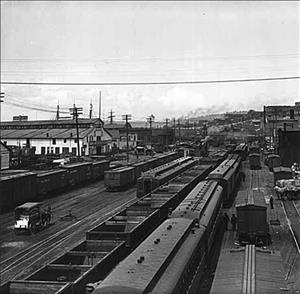Following the Great Fire of 1889, which consumed the harbor from Yesler's Wharf below Pioneer Square to as far north as University Street, the Northern Pacific Railroad rebuilt and extended over-water tracks along the waterfront. The trestles were eventually planked over to create a dangerous, noisy "Railroad Avenue" between the upland downtown and open water.
The Great Northern Railway relieved some of the pressure by agreeing to build a tunnel to send its trains, which entered Seattle from the north, beneath the downtown to a new terminal, King Street Station, and rail yards on the former tidelands east and south of Pioneer Square. Workers toiled between 1903 and 1906 to finish the tunnel, which they joked was the world's longest because it ran from "Virginia to Washington" (streets, that is).
A seawall and Alaskan Way replaced Railroad Avenue in the mid-1930s. The Alaskan Way Viaduct was added in the early 1950s, once again walling off the waterfront from downtown.
To go to Part 7, click "Next Feature"
Sources:
Clarence B. Bagley, History of Seattle (Chicago: S.J. Clarke Publishing Co., 1916) and History of King County (Chicago: S. J. Clarke Publishing Co., 1929); Richard C. Berner, Seattle in the 20th Century, Vols. 1, 2 & 3 (Seattle: Charles Press, 1991, 1992 & 1999); Padraic Burke et al., Pioneers and Partnerships: A History of the Port of Seattle (Seattle: Port of Seattle, 1995); Walt Crowley, National Trust Guide: Seattle (New York: Preservation Press, 1998); Paul Dorpat, Seattle Now & Then, Vols. I, II & III (Seattle: Tartu Press, 1984, 1988 & 1989); Edmond S. Meany, History of the State of Washington (New York: MacMillan Company, Publishers, 1950); Murray Morgan, Skid Road (New York: Viking, 1951); David J. Olson, et al., Port in a Storm: An Historical Review of the Founding of the Port of Seattle (Seattle: Port of Seattle, 1970); Roger Sale, Seattle: Past & Present (Seattle: University of Washington Press, 1976); James R. Warren, King County and its Queen City: Seattle (Woodland Hills, CA: Windsor Publications, Inc., 1981).
Licensing: This essay is licensed under a Creative Commons license that
encourages reproduction with attribution. Credit should be given to both
HistoryLink.org and to the author, and sources must be included with any
reproduction. Click the icon for more info. Please note that this
Creative Commons license applies to text only, and not to images. For
more information regarding individual photos or images, please contact
the source noted in the image credit.

Major Support for HistoryLink.org Provided
By:
The State of Washington | Patsy Bullitt Collins
| Paul G. Allen Family Foundation | Museum Of History & Industry
| 4Culture (King County Lodging Tax Revenue) | City of Seattle
| City of Bellevue | City of Tacoma | King County | The Peach
Foundation | Microsoft Corporation, Other Public and Private
Sponsors and Visitors Like You

